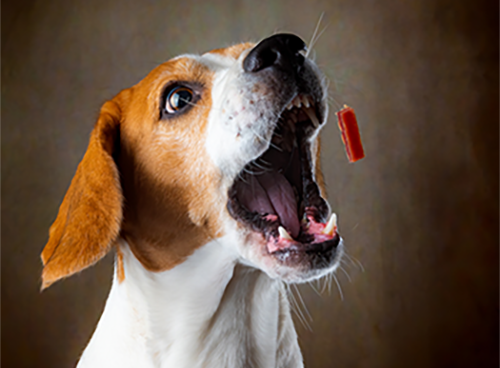Solution #3 for Dog Training Success
Reinforce correctly for magical results
Reinforcement can be magical when used correctly because your dog will learn more quickly and you both will have more fun. Reinforcement builds awesome skills without your dog becoming worried, afraid, or hurt. It is so gratifying to share those moments of success with your dog.
Because 7 is a magic number, here are 7 tips to use reinforcement and start building magical results.
ONE: Understand what reinforcement is (commonly known as rewards).
Before we learn to use reinforcement/rewards correctly, a definition of sorts is in order. Reinforcement is anything that strengthens a behavior. Positive reinforcement means you are adding or giving something; it’s not a value judgment like good or bad. Basically, it is something your dog loves, wants more of, and will work for. Used correctly, it will build drive and motivation. It can create a learning addict! All I need to do is take out my clicker or fill my treat pouch and my dogs get excited to learn something new.
Used correctly, positive reinforcement can teach appropriate behaviors quickly.
Used incorrectly, reinforcement can build undesirable behaviors and confuse your dog.
Huh? How does that work?
Here is how to use positive reinforcement correctly.
You want your dog to look at you more often. Easy peasy, just reinforce him every time he does it. A lightbulb will go off in his head pretty quickly. All he has to do is turn toward you or give you eye contact and a treat appears (a reinforcer/reward), so he keeps doing that. Nice!
Uh oh, this is how it’s used incorrectly.
Your dog jumps on you to greet you. You unconsciously place your hands on him and pet him (or even push him off). He likes the attention (a reinforcer) so he keeps doing it. Darn! It is so easy to teach something we don’t like or want (and then often blame the dog)!
Positive reinforcement is the opposite of a type of punishment, called positive punishment, which means adding or doing something scary, uncomfortable, or painful to your dog to decrease a behavior (such as yelling, hitting, yanking or popping the leash, grabbing/scruffing, forcing down on his back, etc.). Don’t punish your dog for failing to listen or respond correctly: it demotivates and creates fear, stress, and frustration in your dog (and in you). It can be as simple as a harsh tone of voice; most dogs respond best to happy, playful tones of voice. We want training to be fun (your dog does too!).
There’s a big mistake we have all made where we think we are training our dog, but they may be training us… essentially neither one really understands what the other thinks is happening.
TWO: Choose the right type of reinforcement
As you can see from the examples above, reinforcement comes in many varieties; If your dog wants it enough, she will work for it and learn. Most reinforcement falls in the categories below:
- food
- attention
- praise
- petting
- toys
- play
- getting to do something your dog enjoys (often called life rewards…See Tip #7)
Rank how your dog responds to the reinforcers from loves it to meh so you will know which one to choose for a particular exercise. If the exercise is challenging, or in a new environment, choose one that’s higher on the list and more valuable to your dog. For something easy that your dog knows effortlessly, choose something lower on the list. If you offer your dog a specific reinforcer, such as petting, and she turns away, she is not valuing it, at least at that moment. If she is working half-heartedly, try something of higher value and see if you get a quicker and more enthusiastic response.
Doesn’t the use of food create a beggar?
Only if you let it. If you feed your dog from the table, she will learn to pester you at the table. You just reinforced that pestering by feeding your dog in a situation that quickly became annoying. See how simple and powerful reinforcement can be? She wasn’t trying to control you; she was merely living her life learning how to get what she likes and values.
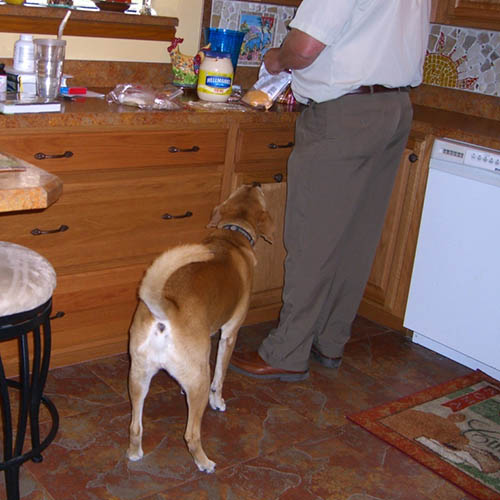
Feed your dog in the kitchen or from the table and your dog will learn that it’s okay to beg or bug you. This is how we inadvertently build behaviors that some find annoying.
Don’t be afraid to use food such as chicken, low-fat hot dogs, cheese, or anything that your dog craves and does not create GI issues. Be sure it’s cut as small as the nail on your pinky (about ¼”). It’s all about how often you reinforce your dog (called the rate of reinforcement, or ROR), not how big the piece of food is.
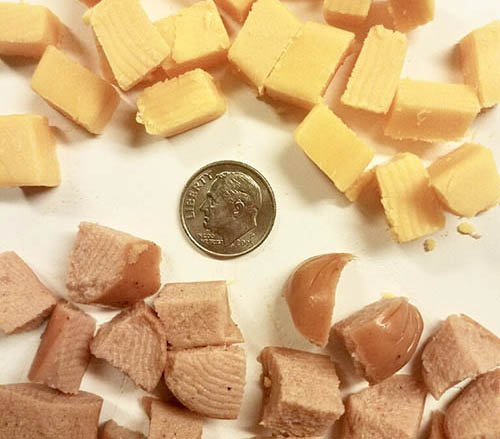
Keep it small, use variety, and discover what your dog loves.
THREE: Pay handsomely
That means, don’t be stingy. Reinforce quickly after every repetition of a behavior your dog performs. Don’t be afraid of continuing to reinforce. Your dog can begin to catch on quickly, but to become fluent where your dog can respond in any situation 90% of the time, takes time consistency, and practice.
How fast do you need to pay up? It’s best to reinforce within a second of the behavior occurring. Even better, use a marker such as a clicker or a special word to indicate that your dog responded quickly. Then follow with a reinforcer within a second of the marker. (See our Training Mistakes article #1 to learn more about this and other super useful tips at https://therealdognerds.com/do-not-cut-corners/.)
Here’s an example. Your dog looks at you (a good thing you want to build) but you give him the treat too slowly and he is already looking elsewhere. In his mind, he is not going to connect the treat with looking at you. However, if you mark the look while he is still doing it by clicking (or using a verbal marker), he knows he has done the right thing and will expect his treat. (Check out our course to build focus and attention in your dog at https://therealdognerds.com/focus/)
Can a reinforcer ever slow learning?
That’s an excellent question! Here are ways that learning can be impeded.
- Your timing is consistently off (too slow or too infrequent so your dog gets confused or demotivated).
- You are using a reinforcer your dog does not value. You think praise or petting is good enough but your dog may disagree, at least at that moment.
- The reinforcer is distracting. You are holding the treat or toy in front of your dog’s face and he just stares at it and does not pay attention to you. Tips: Leave it in your treat pouch (behind you) until ready to give it; or hold it in your closed hand at chest level or behind your back; or keep it on a table or counter that’s easy for you to reach.) Don’t reach for it or present it to your dog until after the behavior has been completed.
- You don’t realize that you are getting frustrated, and your dog, sensitive and perceptive creature that she is, thinks it’s her fault.
- Your dog is stressed or anxious or over-excited due to outside circumstances and it goes unrecognized. Something that used to be fun is now paired with something scary in your dog’s mind. An example is a dog who becomes afraid of going outside because of something frightening out there. As soon as he sees the leash or harness (which used to mean something fun was going to happen) he runs out of the room because it now predicts something scary is going to occur.
- You unknowingly create a chain of behaviors: Your dog jumps up; you tell him “off”; he gets off, and you reinforce him with praise or a treat. Now he’s jumping and expecting the cue, “off”.
- You don’t give your dog a chance to think about what you asked for. Instead, you nag your dog or get frustrated. Be patient and wait him out when it’s called for.
- You back off on the reinforcement too soon and before the behavior has been fully integrated by your dog. You assume your dog has fully learned the behavior and when he does not respond appropriately you begin to blame him for being “lazy”, “willful”, or “stubborn”. (See the training article #2 about mistakes made when you label your dog. You can find lots of great tips at: https://therealdognerds.com/toss-those-labels/)
FOUR: Don’t allow your dog to practice unacceptable behaviors. Observe and reinforce only the ones you like.
We already discussed how easy it is to inadvertently reinforce undesirable behaviors. It’s easier to prevent undesirable behavior and teach good behavior than to try to change an annoying learned behavior. If you don’t want your dog jumping on guests, place him on a leash, and don’t allow him to get close enough to jump. Instead, have him sit and reinforce that calm behavior with high-value food. (Otherwise, your guests will probably pet your jumping dog and he has just been reinforced to continue that behavior.)
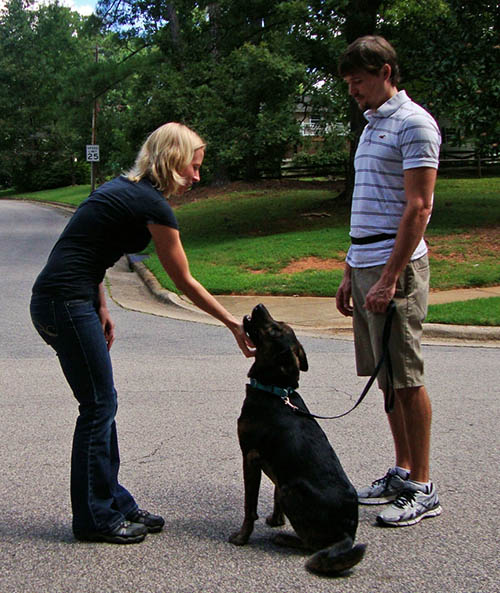
Good dog! He is getting reinforced with attention and petting for sitting calmly.
If you don’t want him barking out the window at things going by, keep him away from the windows, in another room, close the shades, or cover the lower portion of the window. If he hears or sees something and doesn’t bark, or even better, turns toward you instead, reinforce that good choice, or help him by quickly calling him over before barking to get reinforced.
Randomly reinforce your dog for doing the behaviors you like throughout the day, such as quietly lying on his bed with a toy. Catch him doing the things you love and manage his environment so that he is less likely to do something naughty. This is much more productive than nagging him whenever he does something wrong.
Dogs stop performing non-productive behavior when it’s not reinforced. In other words, if the behavior is fruitless, your dog won’t do it anymore. It is that simple. If your dog is continuing to perform a behavior, somewhere, at some point, he is still receiving reinforcement. If you consistently remove the reinforcement, the behavior will decrease and very often disappear entirely. If you also massively reinforce another, alternate behavior that you prefer (such as sitting instead of jumping), your dog will start to perform that instead!
If your dog pulls toward a squirrel and you unconsciously move even 12” closer, you have reinforced the behavior. Instead, stand at a spot an appropriate distance from the squirrel and reinforce your dog for looking away from it, or looking at you.

This little cutie is slowly making her way into this lap. If you don’t want that but it’s allowed to happen, she will do it more. Decide what your rules are and stick to them. (Consider only allowing this type of behavior when you ask for it instead of when she decides.)

This is the type of behavior we often ignore but should reinforce often so that we get more of it! Pay attention and catch your dog behaving appropriately.
FIVE: Train and reinforce during the right state of mind (your dog’s, but yours counts too (…see the bonus tip).
Reinforce calm and focused behavior. Dogs learn best when in this state. If your dog is over-excited or aroused learning slows or stops. Reinforcement can often be useless in this situation, or you can inadvertently condition this excited behavior.
When your dog is calmly engaged, he may offer behaviors. Click and pay for the ones you like. This is called capturing. In the example described earlier, you can capture your dog’s attention just by quietly waiting for her to look at you and then paying it.
Some reinforcers will create a higher energy/arousal level and others can be more calming. Figure out which is which for your dog. For my dogs, the appearance of a tennis ball, which is hugely appealing to them (high on their ranked list) gets them very excited. Low-value treats, on the other hand, keeps them calmer. (My energy level also affects them.)
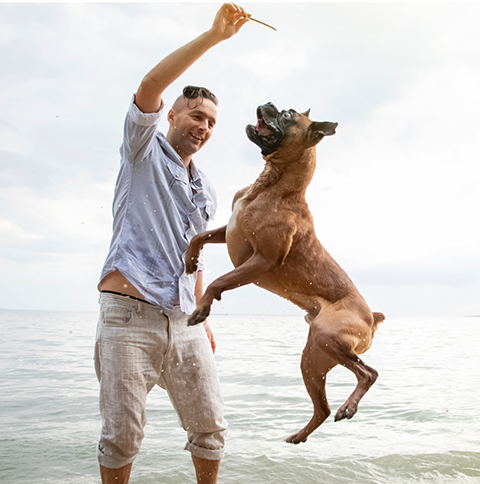
This dog is playing in a very aroused and excited state. If asked for an obedience behavior, he might not be able to respond.
How and where you give the reward also has an effect. I can deliver it to bring my dogs close to me by providing it in a specific area next to me and from my hand. Or I can toss it to keep them moving and more animated.
Food can be used to calm and focus a dog. Try tossing a handful in the grass and allow them to quietly sniff and search for it.
SIX: Adjust the lesson when needed.
Only reinforce the behaviors you like. Don’t reinforce just for the heck of it or it becomes meaningless.
Each day is a fresh training day. Your dog may quickly learn one day and then struggle the next. That’s okay. We often learn in a similar fashion. Don’t be afraid to adjust the level of training to accommodate your dog’s needs. You may have gotten to only reinforcing the ‘stay’ every 60 seconds, but one day you are working in a new and distracting environment, and he can’t stay for more than 20 seconds. That is merely information for you to make an adjustment so that your dog can be successful.
- Change the situation.
- Change your attitude (don’t work while angry or frustrated).
- Find someplace less distracting or quieter.
- Observe your dog’s state of mind (arousal level or anxiety) to be sure it is optimal for learning.
- Increase the rate of reinforcement (how often he gets the reward).
- Change the value (make it better if you need more attention, or lower the value if you need to calm a dog who is too excited by the treat to think) or the type of reinforcement.
- Reinforce smaller baby steps to make the lesson easier and your dog more successful.
Keep him happy, motivated, and eager to earn reinforcement, and he will continue to succeed.
SEVEN: Do I need to reinforce forever?
Yup! You need to continue to reinforce your dog’s great behaviors, or they may slowly deteriorate or disappear. You just don’t need to do so at the same pace as when you were teaching them the skill.
Naturally, over time, we begin to ask our dog to do a little more to earn reinforcement. As an example, when we are practicing ‘stay’ we start with reinforcing the dog’s position every second or two. Over time and with incremental success, we build in more and more time between treats so eventually, your dog is getting fewer and fewer treats for the same (but more skilled) behavior.
Here’s another example. Your dog is learning to walk next to you without pulling. At first, we may
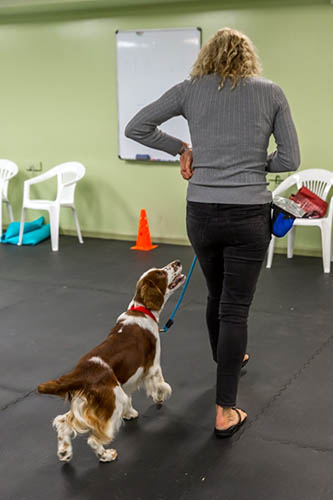
This spaniel has been reinforced consistently and can remain focused even in a classroom setting.
reinforce every step, then every two, then three, and so on, if your dog is responding correctly. Over time, you will begin to reinforce occasionally or only the most excellent examples of the behavior (or when it’s the most challenging such as in a distracting environment).
As your dog builds understanding by receiving reinforcement such as food, you can maintain behavior using life rewards. That means your dog is getting the end result he values or the activity he enjoys. Dogs herd sheep and do dog agility not because they get treats but because they get to do something they love! The activities alone are reinforcing. Your dog learns to wait to exit the door to go outside because he gets reinforced with freedom, a fun walk, or playtime.
Check out the poodle in the video below. She is doing agility because she loves it; no additional reinforcement is needed at this level. It has become intrinsically rewarding because it was taught in a manner to keep her motivated and joyful.
BONUS TIP: Being kind to yourself affects your dog in a positive way.
Practice self-compassion. Don’t be self-critical when dealing with training setbacks. And be present in the moment with your dog; don’t dwell on past difficulties. Your inner voice should be supportive, not self-critical. This will help your dog’s attitude as well and he will want to be more involved with you and optimistic rather than thinking that your anger and disappointment about your own mistakes is due to you being unhappy with him. The tone of your voice and facial expressions have a direct impact on your dog’s emotional state. Use calm, positive language and attitude. That begins with you feeling good about yourself and what you’re achieving, even the baby steps.
Express gratitude for the positive moments with your dog. Every day, think about the things you enjoyed about your dog and write down three of them, such as placing his head on your lap and gazing at you with love and affection. Be aware and appreciative of these small moments.
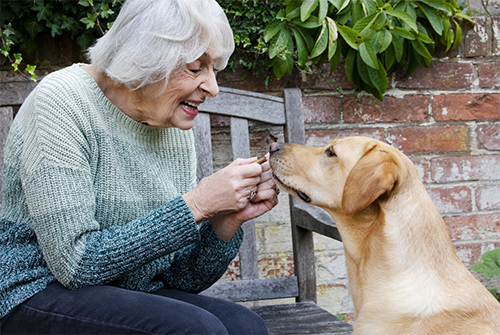
Previous posts in this series:
Dog Training Solution #1: If you want training success, don’t cut corners

